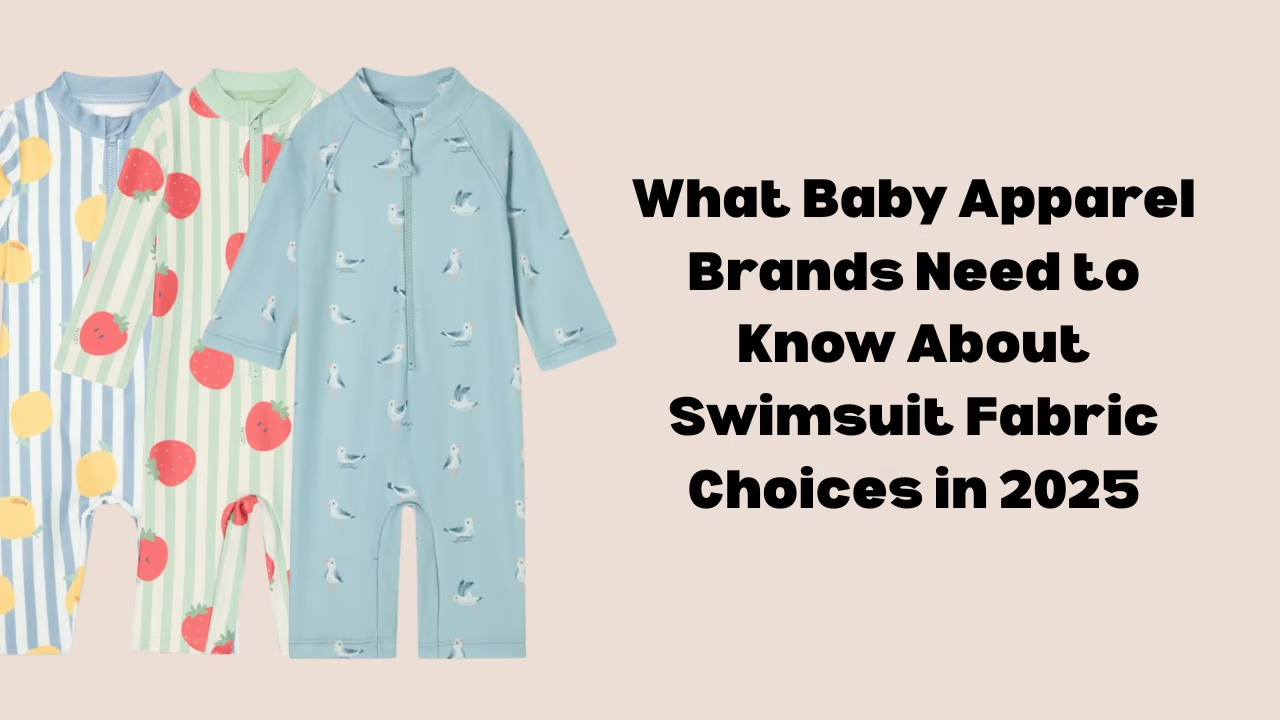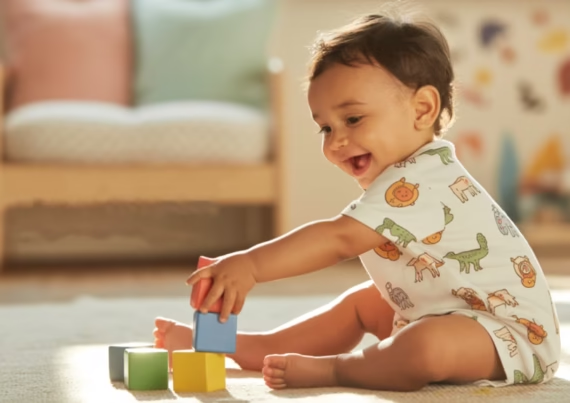What Baby Apparel Brands Need to Know About Swimsuit Fabric Choices in 2025

Introduction
Swimwear for babies is more than just a cute accessory—it’s a necessity that ensures comfort, safety, and durability while they splash around in the water. Choosing the right fabric for baby swimsuits is a critical decision for baby apparel brands. Baby skin is delicate and sensitive, and the wrong fabric can lead to discomfort or even skin irritation. In this article, we will explore the best fabric choices for baby swimwear in 2025 and explain why brands need to be mindful of fabric selection for a successful and safe swimwear collection.
Top Fabric Choices for Baby Swimwear
There are several fabric options for baby swimwear that balance comfort, durability, and skin safety. Each fabric type has its own unique set of benefits, so baby apparel brands need to make informed choices based on their target audience and product goals.
-
Nylon:
Nylon is one of the most popular fabrics for swimwear, and for good reason. It’s lightweight, breathable, and quick-drying, making it perfect for baby swimwear. Babies can spend hours playing in the water without feeling weighed down or uncomfortable. The smooth texture of nylon also helps prevent irritation on delicate skin, making it a top choice for baby swimwear.
-
Polyester:
Polyester is another durable option that is resistant to chlorine and fading. Polyester swimsuits can withstand prolonged exposure to saltwater, chlorine, and sunlight, making them ideal for frequent swimmers. Polyester is also known for retaining its shape over time, offering a longer lifespan for baby swimwear. Additionally, it’s easy to care for and dries quickly, making it a practical option for busy parents.
-
Spandex/Lycra:
Spandex, often blended with other fabrics like nylon or polyester, offers excellent stretch and comfort. This fabric provides the necessary flexibility for babies to move freely while also offering shape retention, so swimsuits maintain their form even after hours of wear. Spandex blends are perfect for active babies who love to splash around and explore.
-
Bamboo Fabric:
Bamboo fabric is an eco-friendly option that’s becoming more popular in the baby apparel market. Naturally soft and breathable, bamboo fabric is hypoallergenic, making it an excellent choice for babies with sensitive skin. It also boasts antibacterial properties, helping to prevent skin irritation caused by bacteria or moisture buildup. Sustainable brands may find bamboo fabric an appealing choice due to its eco-friendly attributes.
summarize:
| Fabric | Description |
|---|---|
| Nylon | Lightweight, breathable, and quick-drying. Prevents irritation on delicate skin, making it ideal for baby swimwear. |
| Polyester | Durable, resistant to chlorine and fading. Retains shape over time, dries quickly, and is easy to care for. Ideal for frequent swimmers. |
| Spandex/Lycra | Excellent stretch and comfort. Offers flexibility for babies, with shape retention for long-lasting form, making it ideal for active babies. |
| Bamboo Fabric | Eco-friendly, hypoallergenic, and antibacterial. Soft and breathable, ideal for babies with sensitive skin. Appeals to sustainable brands. |

With 17 years of experience, petelulu provides a full range of
manufacturing services from design to delivery.
Start from scratch , Create your own brand.
17+
serving top 10 American brands
15+
serving top 10 Australian brands
12+
serving top 10 European brands
Contact us to get the quote.👇
Fabric Durability and Care for Baby Swimwear
Selecting a durable fabric is important, but knowing how to care for baby swimwear is just as critical to ensure the fabrics last. Understanding the impact of saltwater, chlorine, and sun exposure on fabrics can help extend the life of baby swimwear.
-
Washing and Drying Tips:
To prevent the fabric from deteriorating, it’s crucial to follow proper washing and drying instructions. Always rinse swimsuits after each use to remove chlorine and saltwater. For the best results, hand wash swimwear with mild detergent to maintain the fabric’s elasticity and color. Avoid using harsh chemicals or fabric softeners, as they can break down the material and cause fading.
-
Saltwater, Chlorine, and Sun Exposure:
Saltwater and chlorine are both tough on fabrics, especially if swimsuits are not washed promptly after use. Exposure to these elements can cause fibers to break down, fade, or lose their elasticity. Brands should choose fabrics that are resistant to chlorine and fading, such as polyester, to ensure the longevity of the swimwear.
Skin Safety and UV Protection
Sun protection is a critical aspect of baby swimwear, as babies are especially vulnerable to UV damage. Baby swimwear brands need to ensure that their products offer adequate protection against harmful UV rays.
-
UV-Blocking Fabrics:
Fabrics that naturally block UV rays are ideal for baby swimwear. These fabrics prevent the sun’s harmful rays from reaching the skin, reducing the risk of sunburn. While no fabric can block 100% of UV rays, some fabrics offer a high Ultraviolet Protection Factor (UPF) rating, which indicates the level of UV protection the fabric provides.
-
What Makes a Fabric UV-Protective?
UV-protective fabrics are typically made with tightly woven fibers that block the sun’s rays from penetrating the material. The more tightly woven the fabric, the better it is at providing UV protection. Some synthetic fabrics like polyester and nylon are naturally more effective at blocking UV rays than others, making them an excellent choice for baby swimwear.
-
How UPF Works:
UPF, or Ultraviolet Protection Factor, is a rating system used to measure the effectiveness of fabric in blocking UV radiation. For example, a fabric with a UPF of 50 blocks approximately 98% of UV rays. When shopping for baby swimwear, parents should look for swimsuits with a high UPF rating to ensure the best sun protection for their little ones.
Conclusion
Choosing the right fabric for baby swimwear is more than just a style decision—it’s about ensuring comfort, safety, and durability. Baby apparel brands need to carefully consider the fabric’s ability to withstand sun, saltwater, and chlorine, while also protecting the delicate skin of infants. By focusing on UV protection, fabric durability, and eco-friendly options, brands can offer high-quality, safe, and stylish baby swimwear that meets the needs of both parents and babies. It’s important for brands to stay informed about the latest fabric innovations and make thoughtful, sustainable choices to ensure the best experience for little ones.

With 17 years of experience, petelulu provides a full range of
manufacturing services from design to delivery.
Start from scratch , Create your own brand.
17+
serving top 10 American brands
15+
serving top 10 Australian brands
12+
serving top 10 European brands
Contact us to get the quote.👇
About the author
Xhiney, founder of Petelulu, brings over 20 years of experience in children’s wear design, production, and international trade. A contributor to Children’s Wear and Junior magazines, Xhiney has spent 17 years working with high-end children’s wear brands in Europe and the U.S., offering expert insights and support.
